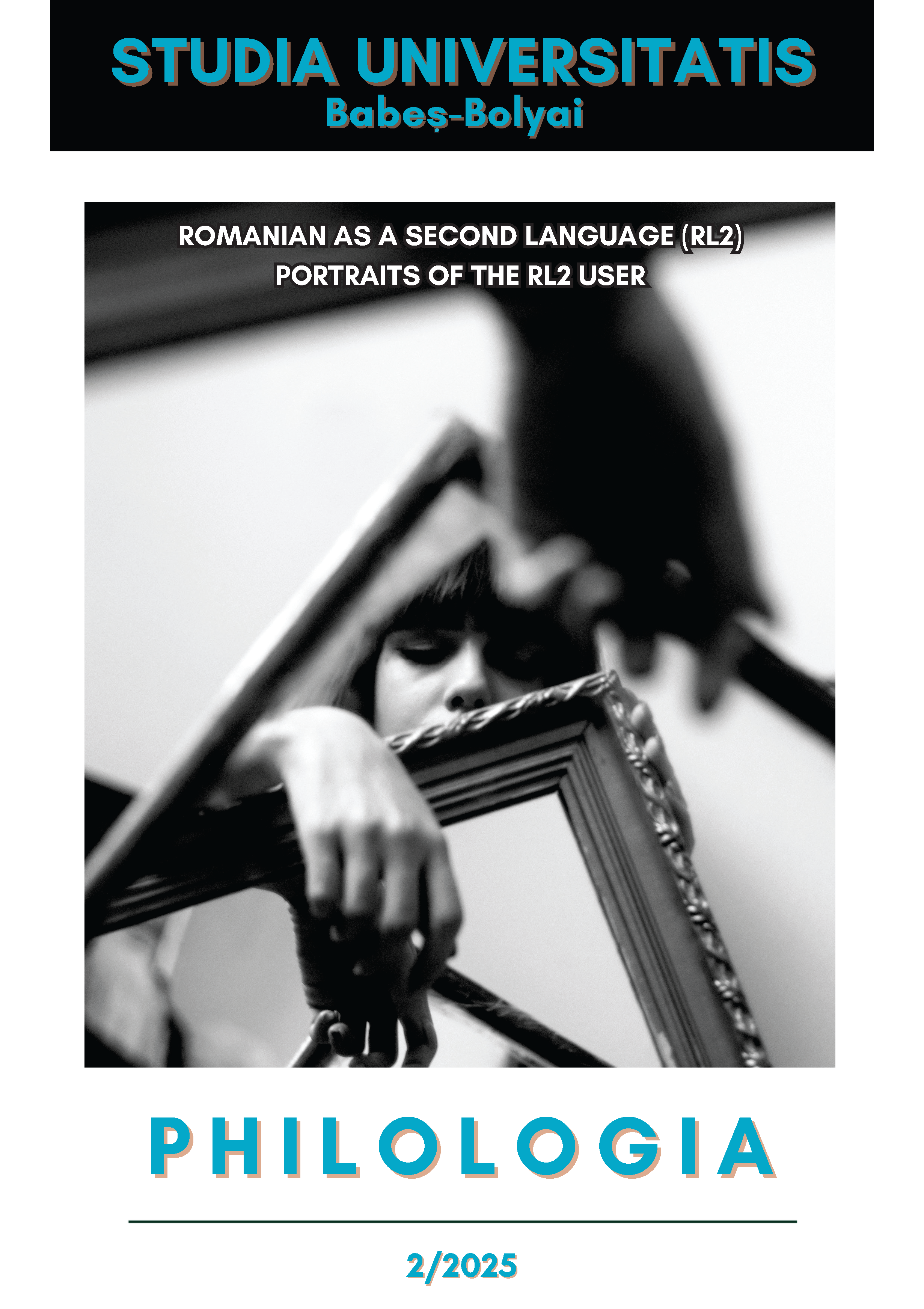LISTENING IN L2 ROMANIAN: WHY FUNCTION WORDS GO UNNOTICED
DOI:
https://doi.org/10.24193/subbphilo.2025.2.03Keywords:
L2 listening, word recognition, function words, content words, input processing, cognitive linguistics, Romanian as a second languageAbstract
Listening in L2 Romanian: Why Function Words Go Unnoticed. Listening is a crucial but often overlooked component of second language (L2) acquisition. Despite its importance in developing linguistic competence, listening is frequently underemphasized in classroom instruction. This article examines L2 listening through the framework of cognitive linguistics, particularly cognitive grammar, which views language as an extension of general cognitive processes such as perception, memory, and categorization. By integrating insights from John Field’s research on input processing and Baddeley’s working memory model, we explore how L2 learners prioritize content words over function words in real-time listening. A small-scale empirical study was conducted with 37 students enrolled in a preparatory Romanian language course, using a paused transcription method to assess word recognition accuracy in speech. The findings confirm that L2 learners rely more on content words over function words, which is consistent with previous research in other languages. Notably, within function words, clitic pronouns and certain conjunctions were particularly difficult to recognize, suggesting that semantic schematicity and phonetic reduction play a key role in perceptual challenges. The study also highlights the continued reliance on top-down processing, even among B1-level learners, and the persistent difficulty in automatic segmentation of spoken input. Finally, the article argues for a reassessment of listening instruction, emphasizing explicit training in speech perception, function word recognition, and phonological processing. A balanced approach, combining comprehensible input, explicit instruction, and structured practice, is proposed to enhance L2 learners’ ability to process spoken language more effectively.
Ascultarea în limba română L2: De ce cuvintele funcționale trec neobservate. În ciuda rolului esențial în achiziția limbii, receptarea mesajului oral este una dintre cel mai puțin reprezentate activități în predare. Perspectiva adoptată e cea a lingvisticii cognitive, mai precis a gramaticii cognitive, și valorifică o serie de studii dedicate în special decodării și recunoașterii cuvintelor în receptarea mesajului oral (Field 2009, Baddeley 2003). Scopul cercetării este ca, pornind de la un studiu empiric la scară mică, să aflăm în ce măsură vorbitorii de RLS prioritizează cuvintele cu conținut lexical față de cele cu conținut gramatical în ascultare. Metoda utilizată a fost cea a transcrierii cu pauză. Rezultatele confirmă faptul că vorbitorii de L2 se bazează mai mult pe cuvintele cu conținut lexical decât pe cele cu conținut gramatical, ceea ce este în concordanță cu cercetările anterioare pe alte limbi. În special, în cazul cuvintelor funcționale, pronumele și anumite conjuncții au fost dificil de recunoscut, probabil datorită schematismului semantic, formelor reduse din punct de vedere fonetic și poziției neaccentuate. Studiul evidențiază, de asemenea, înclinația spre o procesare vârf-bază, chiar și în rândul cursanților de nivel B1, și dificultățile întâmpinate de aceștia în segmentarea automată a inputului vorbit. În final, articolul pledează pentru o reevaluare a felului în care ascultarea e abordată în predare, subliniind importanța unor activități dedicate explicit decodării și recunoașterii cuvintelor, în special a celor cu conținut gramatical și relațional. O abordare echilibrată, care combină expunerea la input, predarea explicită și exersarea sistematică ar putea spori capacitatea cursanților L2 de a procesa mai eficient limba vorbită.
Cuvinte-cheie: ascultare L2, segmentare, decodare, cuvinte funcționale, specificitate semantică, schematism semantic, lingvistică cognitivă, româna ca limbă străină
Article history: Received 14 February 2025; Revised 4 April 2025; Accepted 7 May 2025;
Available online 10 June 2025; Available print 30 June 2025.
References
Baddeley A. 2003. “Working memory: looking back and looking forward”. Nat Rev Neurosci, Oct;4(10): 829-839.
Baddeley, A. 2000. “The episodic buffer: a new component of working memory?” Trends Cogn. Sci. 4: 417–423.
Doughty, C. 2004. “Effects of Instruction on Learning a Second Language: A Critique of Instructed SLA Research”. In Form-Meaning Connections in Second Language Acquisition. Edited by Bill VanPatten et al, 181-200. NJ: Lawerence Erlbaum and Associates.
Field, John. 2009. Listening in the Language Classroom. Cambridge: Cambridge University Press.
Field, John. 2008. “Bricks or Mortar: Which Parts of the Input Does a Second Language Listener Rely on?”. TESOL Quarterly, Volume 42, Issue 3: 411-432.
Krashen, S. 1985. The Input Hypothesis: Issues and Implications. London: Longman.
Langacker, R. 2007. “Cognitive Grammar”. In The Oxford Handbook of Cognitive Linguistics. Edited by Dirk Geeraerts and Hubert Cuyckens, 421-463. Oxford: Oxford University Press.
Lightbown, P. and Spada, N. 2017. How Languages Are Learned (Fourth Edition). Oxford University Press, Oxford.
Pienemann, M. 2003. “Language Processing Capacity”. In The Handbook of Second Language Acquisition. Edited by C. J. Doughty and M. H. Long, 679-714. Oxford: Oxford University Press.
Rost, Michael. 2011. Teaching and Researching: Listening. London: Routledge.
Schmidt, R. 2001. “Attention”. In Cognition and Second Language Instruction. Edited by P. Robinson, 3-32. Cambridge: Cambridge University Press.
Vafaee, P, Suzuki, Y. 2020. “The relative significance of syntactic knowledge and vocabulary knowledge in second language listening ability”. Studies in Second Language Acquisition 42 (2): 383-410
Vandergrift, Larry. 2004. “Learning to listen or listening to learn?”. Annual Review of Applied Linguistics, 24: 3–25.
Vandergrift, Larry, Goh, Christine. 2012. Teaching and Learning Second Language Listening. Metacognition in Action. London: Routledge.
VanPatten, B. 2004. “Input Processing in SLA”. In Processsing Instruction: Theory, Research and Commentary, edited by B. VanPatten, 5-33. NJ: Lawerence Erlbaum and Associates.
VanPatten, B. 2004. “Input and Output in Establishing Form-Meaning Connections”. In Form-Meaning Connections in Second Language Acquisition. Edited by Bill VanPatten et al, 181-200. NJ: Lawerence Erlbaum and Associates.
Vigliocco, G., Vinson, D. P., Druks, J., Barber, H., & Cappa, S. F. 2011. “Nouns and verbs in the brain: A review of behavioural, electrophysiological, neuropsychological and imaging studies”. Neuroscience and Biobehavioral Reviews, 35(3): 407–426.
Downloads
Published
How to Cite
Issue
Section
License
Copyright (c) 2025 Studia Universitatis Babeș-Bolyai Philologia

This work is licensed under a Creative Commons Attribution-NonCommercial-NoDerivatives 4.0 International License.



